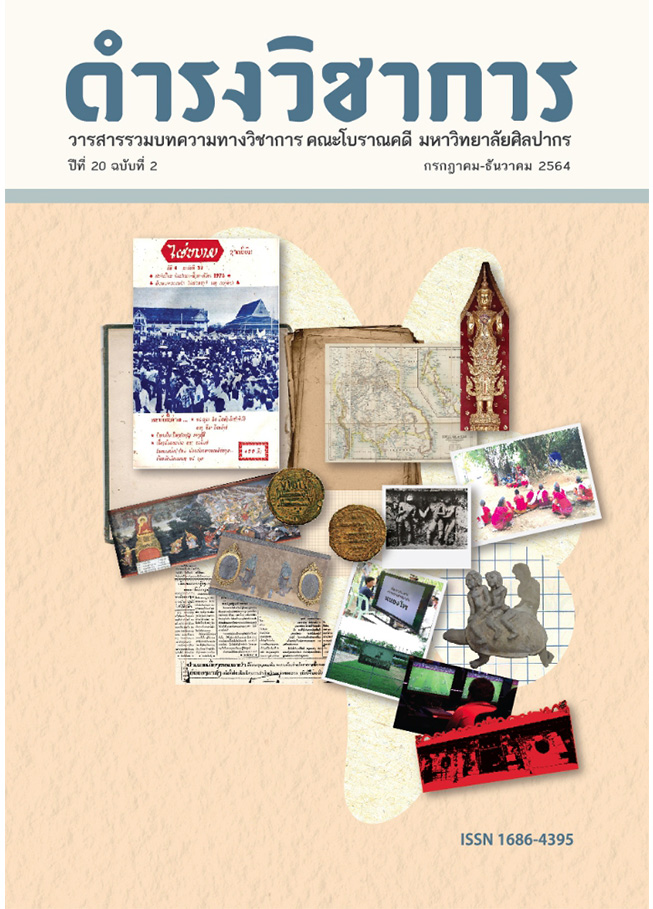Krahang and The Crisis of Masculinity in Contemporary Urban Society
Keywords:
Crisis of Masculinity, Krahang, Capitalism, Consumerism, Contemporary Urban SocietyAbstract
Part of the series Phi Mahanakorn, written by Tawiwat, the novel Krahang is an urban gothic novel. It uses fantasy in the form of supernatural beings, or Krahang, which are male ghosts from Thai folklore, to represent the crisis of masculinity of the lead characters, Alex and Aun. Following a shift in space and social context after Alex and Aun move into contemporary urban Bangkok society, the Krahang’s appearance and behaviors change to reflect the different experiences and emotional interactions of the characters and align their crisis of masculinity with concepts prevalent in contemporary urban society such as capitalism and consumerism. Moreover, representation of the crisis of masculinity through Krahang also reveals other unquestioned sides of contemporary urban society. However, the different way of life and decisions of the characters leads to different results that not only strengthen norms but also offer some options for living in contemporary urban society.
References
ภาษาไทย
ชุติมา ประกาศวุฒิสาร, 2563. หญิงร้ายในกายงาม: ความเป็นหญิงกับวิกฤติความเป็นสมัยใหม่ในสังคมไทย. กรุงเทพฯ: โครงการเผยแพร่ผลงานวิชาการ คณะอักษรศาสตร์ จุฬาลงกรณ์มหาวิทยาลัย.
ทวิวัฒน์, 2561. กระหัง (ผีมหานคร). กรุงเทพฯ: Sofa Publishing.
นัทธนัย ประสานนาม, 2552. โดยนัยนี้ อีกนัยหนึ่ง. กรุงเทพฯ: สำนักพิมพ์มหาวิทยาลัยมหาสารคาม.
นิติ ภวัครพันธุ์, 2541. “รอยสัก กับการสร้าง “ตัวตน”.” ใน ปริตตา เฉลิมเผ่า กออนันตกูล (บรรณาธิการ), เผยร่าง-พรางกาย ทดลองมองร่างกายในศาสนา ปรัชญาการเมือง ประวัติศาสตร์ ศิลปะ และมานุษยวิทยา (หน้า 185-234). กรุงเทพฯ: โครงการจัดพิมพ์คบไฟ.
สุรเดช โชติอุดมพันธ์, 2559. อ่านเมือง เรื่องคนกรุง: วรรณกรรม วิถีความสัมพันธ์ และภาพแทนของพื้นที่. กรุงเทพฯ: โครงการเผยแพร่ผลงานวิชาการ คณะอักษรศาสตร์ จุฬาลงกรณ์มหาวิทยาลัย.
ภาษาอังกฤษ
Anuman Rajadhon, Phya, 1954. “The “Phi”.” M. Coughlin (Ed.) JSS 41.2: 153-178.
Botting F., 2014. Gothic. Oxon: Routledge.
Bourdieu P., 2010. Distinction. (Translated by R. Nice). Oxon: Routledge.
Bowley B., 2013. “Soft boys, tough boys and the making of young sporty masculinities at a private boys' school.” Agenda 27 (3): 87-93.
Felski R., 1995. The gender of modernity. Massachusetts: Harvard University Press.
Gardiner J.K., 2012. “Female masculinity and phallic women-unruly concept.” Feminist Studies 38 (3): 597-624.
Jarvis B., 2007. “Monsters Inc.: Serial killers and consumer culture.” Crime Media Culture: An International Journal 3 (3): 326-344.
McRuer R., 2019. “Compulsory able-bodiedness.” In G. Weiss, A. V. Murphy & G. Salamon (Eds.), 50 concepts for a critical phenomenology (pp. 61-67). Illinois: Northwestern University Press.
Newitz A., 2006. Pretend we're dead: Capitalist monsters in American pop culture. North Carolina: Duke University Press.
Pile S., 2005. Real cities. London: SAGE Publications Ltd.
Royle N., 2003. The uncanny. Manchester: Manchester University Press.
Simonsen K., 2000. “The body as battlefield.” Transactions of the Institute of British Geographers 25 (1): 7-9.
Downloads
Published
Issue
Section
License
Copyright (c) 2021 Damrong Journal of The Faculty of Archaeology Silpakorn University

This work is licensed under a Creative Commons Attribution-NonCommercial-NoDerivatives 4.0 International License.
บทความนี้เป็นผลงานของข้าพเจ้าแต่เพียงผู้เดียว และ/หรือเป็นผลงานของข้าพเจ้าและผู้ร่วมงาน ตามชื่อที่ระบุในบทความจริง และเป็นผลงานที่มิได้ถูกนำเสนอหรือตีพิมพ์ที่ใดมาก่อน





